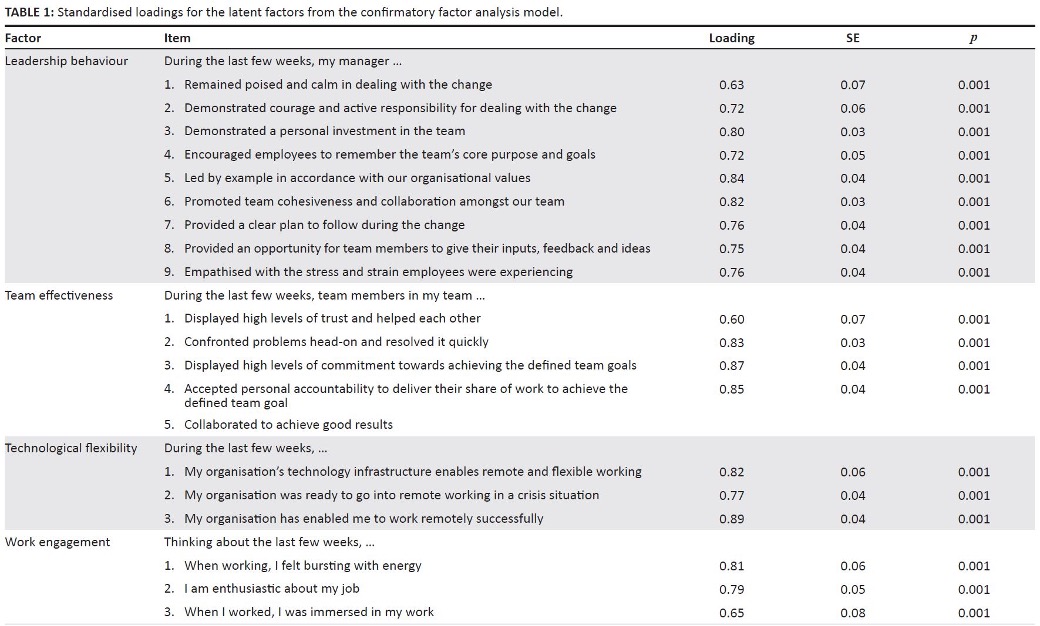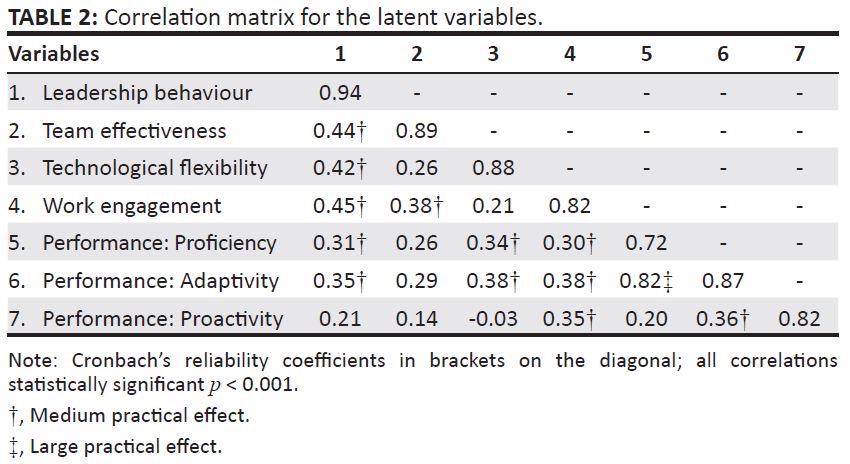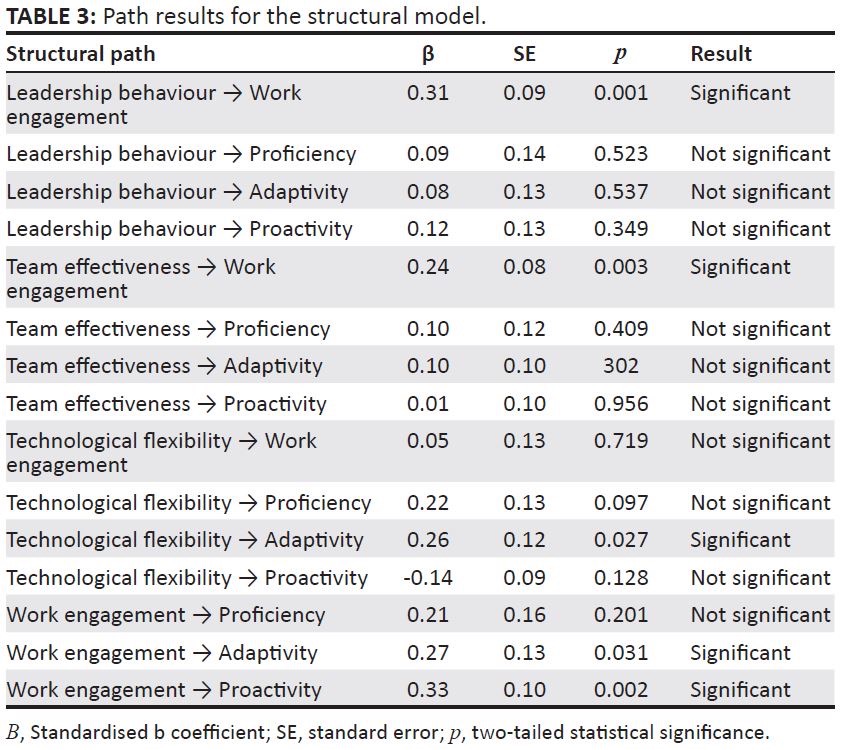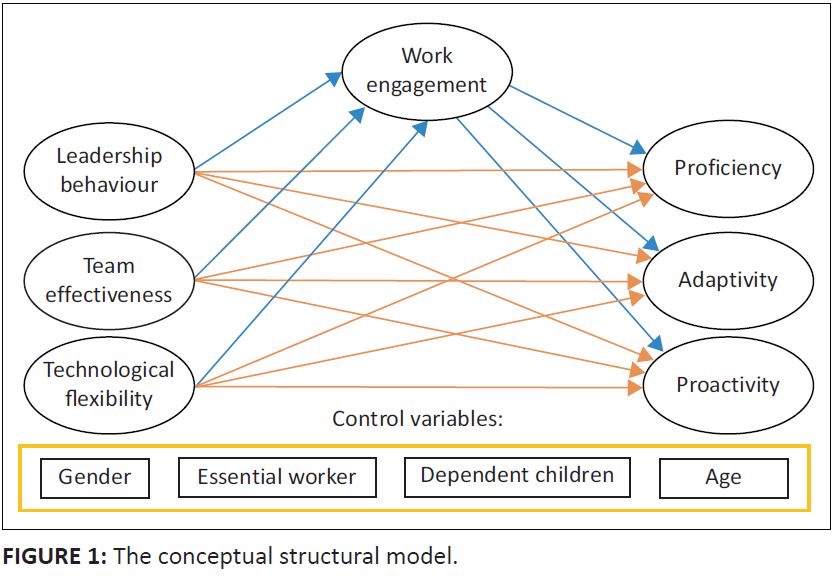
Leadership behavior and its effects during Covid-19 lockdown
Introduction
The coronavirus disease of 2019 (COVID-19) and the attendant lockdown measures put in place by the majority of countries have without a doubt been the most important events of the twenty-first century. In accordance with the law, the South African government announced a state of emergency and adopted a “full closure” strategy, which denotes an extremely strict set of rules but also, when compared to New Zealand and few EU members, perhaps one of the strictest sets of closure rules in the entire world (Disaster Management Act, 2002). Only those jobs and organizations designated as providing critical services are permitted to leave their residences during the harsh lockdown, and all other commercial locations are kept closed (Government of South Africa, 2020). However, numerous continuous developments have been put in place to make it possible for people in other areas to work from home. This condition presents a challenge to leadership, and there is scant evidence to support the impact of leadership on remote employees’ performance and work engagement in a lockdown situation (Lacerda, 2019). As leaders goes through the most hectic conditions once only seen during the financial crisis of 2008, leadership will play an extremely important role in navigating the resources for a healthier outcome in these unusual times (Walker et al, 2016).
The choices made by leaders on the technologies made available to employees and clients will not only affect how well a team works together remotely but may also have a significant impact on the organization’s future. Due to the negative news around Covid-19 lockdown and the toll it took on mental health of workers as well as researchers who investigated the effects while being in lockdown setting, the researcher decided to draw the current research by utilizing an optimistic psychological perspective. He achieved this by concentrating on particular resources that, given the lockdown’s conditions, may be crucial to employees at home and that boost motivation and performance. Hence why the goal of this research was to find a model which can act as a boost to performance and motivate South African employees who were working from home during the lockdowns period.
Literature Review
The job demands-resources (JD-R) model’s motivational process serves as the study’s theoretical foundation (Bakker & Demerouti, 2017). The motivational process of the JD-R model illustrates in detail how job resources made freely available to employees in their current work setting which led to work engagement (comprising vigor, devotion, and absorption), that in turn affects employee outcomes (Lesener et al, 2019). Performance (proficiency, adaptivity, and proactivity) is the outcome measure in the current study. As a result, occupational resources are linked to positive organizational results in general and good psychological functioning (Van den Broeck, et al, 2010).
Job resources, work engagement and performance
Job resources was established on the basis of result in work engagement and favorable organizational outcomes (Bakker & Demerouti, 2017). Job resources are the organizational characteristics which are essential to accomplishing work goals and may also lessen job demands, according to Demerouti et al (2001). In this study, 4 factors of job engagement and performance were engaged namely- leadership behavior, team effectiveness, technology and flexibility.
In this study, leadership behavior was utilized to measure participants’ impressions of their leaders in light of the change that the lockdown forced upon them. This was specifically based on Prewitt and Weil’s (2014) work, which explains how leadership can alter organizational stress using technical (quick fixes, setting procedures for known problems) or adaptive techniques (addresses fundamentals and dysfunctional dynamics), but crisis leadership realizes that this is insufficient in the long run without an adaptive response. Leadership has been found to affect outcomes like performance and motivational states like job engagement (Caulfield & Senger, 2017). Specifically, there were 3 work role behaviors which were employed for this study as those are associated with a positive effect- proficiency (fulfills the prescribed or predictable requirements of the role), adaptivity (copes with, responds to, and supports change), and proactivity (initiates change, is self-starting, and future-directed) (Griffin et al., 2007). Performance has also been proven to be impacted by work engagement (Gauche & De Beer, 2018).
In addition to taking into account the resources which are used effectively in order to achieve work goals, team effectiveness was used in this study as a collegial resource. Job resources that included peer support were found to be both a protective factor against burnout and a positive predictor of work engagement by De Beer, Rothmann, and Pienaar (2012).
The proposed exploratory model therefore suggests that job engagement may have a mediating role in the interaction between leadership, behavior, team effectiveness, and technological adaptability, and the performance indicators (Zhao et al, 2010). According to this study, work engagement is a key mediating factor in this situation (Bakker & Demerouti, 2017).
Methodology
Participants
A cross-sectional quantitative survey approach had been employed in which 219 people (n = 219) made up the sample. Although the poll was available during the lockdown, this study only examined the data from 14 May to 28 May 2021. Specifically, the Industrial and Organizational Society of Psychology in South Africa and others constructed an online survey using a free license account on Google Forms and posted it on social media sites (such as Facebook and LinkedIn) (Results published on their website). Therefore, this sample is a non-probability sample because individuals were in full control of their decision about whether to participate in this study or not. The study’s inclusion condition required that participants be employed during the lockdown. The participants’ average age was 36.02 years (SD = 10.09), and the majority (n = 154; 68.33%) of them identified as female. The remaining participants all identified as male. In addition, 111 participants (48.47%) said they had dependent children at home or dependents older than 50 (n = 28; 13.00%), and 68 participants (29.69%) said they were employed as vital service workers. When asked about their marital status, 132 (56.04%) interviewees said they were married.
Measuring Instruments
A 9-item scale measuring leadership behavior was developed by the researchers utilizing Prewitt and Weil’s (2014) work as a guide on a scale from 1 – 5 in which 1 stand for strongly disagree with the remark and 5 which subsequently stands for strong agreeing with that remark. Participants’ perceptions of their leader’s behavior during the previous few weeks were gauged using this scale (see Table 1). “In the previous 4-5 weeks, my direct leader… exhibited bravery and took in charge of the responsibility to actively deal with the change,” was an example item from this scale. This scale’s Cronbach’s a coefficient was 0.94, which is regarded as being very acceptable.
The researcher used Patrick Lencioni’s Team Effectiveness model as their guide to create a 5-item scale to measure team effectiveness (Hamlin, 2008). From 1 (strongly disagree) to 5, the scale was used (strongly agree). ” In the previous 4-5 weeks, my colleagues… took in charge of their workload and perform in order to achieve the set team goal.” This scale’s 0.89 Cronbach’s alpha coefficient was deemed satisfactory.
A three-item scale that ranged from 1 (strongly disagree) to 5 (strongly agree) was created by the researchers to gauge technological flexibility. “My organization’s IT infrastructure supports remote and flexible working,” was an example item from this scale. This scale’s Cronbach’s a coefficient was 0.88, which is likewise quite respectable.
The three-item ultra-short Utrecht Work Engagement Scale (Sichafil et al, 2019) measured work engagement on a scale from 1-7 in which 1 stand for never while 7 stand for always. “My work made me feel excited and energized” is an example item. The acceptable Cronbach’s a coefficient for this scale was 0.82.
A modified and condensed 9-item Work Role Performance scale was used to evaluate performance (Griffin et al., 2007). Each of the 3 components had 3 items related to it : (1) proficiency ( = 0.72; for example, “In the previous 4-5 weeks, you made sure that all of your job responsibilities are performed at the highest level possible”), (2) adaptivity ( = 0.87; for example, ” In the previous 4-5 weeks, you showed interest and embarked on learning new skills in order to adjust with the change “), and (3) organizational commitment ( = 0.72; for example, ” In the previous 4-5 weeks, you…carried out the core parts of your job well”).
A scale of 1-7 in which 1 represents not at all pessimistic/optimistic and 7 represents extremely optimistic/pessimistic, the Scale Optimism-Pessimism-2 (Kemperet al., 2017) was used to measure different levels of pessimism and optimism on general basis within participants which are therefore used for analysis. This study has demonstrated that optimism and pessimism are not always viewed on a continuum, hence the items were employed separately in the current study.
Statistical Analysis
Confirmatory factor analysis (CFA) was used including Mplus 8.4 and an aggressive maximum likelihood estimation approach that is robust to the probability of non-normality in the data (Muthén, 2019). Significantly, given the context in which data collection was conducted and the participants’ inherent bias in responding to the survey, all items were scaled for optimistic and pessimistic observations to reduce possible bias and they were regressed to a value. The CFA model shown in Figure 1 was provided by Mplus. As a result, control at the item level was calculated when creating the measurement model in the CFA model.
Comparative fit index (CFI), Tucker-Lewis index (TLI), Root mean square error of approximation (RMSEA), and standardized root mean square residual (SRMSR) were used as standard fit measures for the models. Correlations were also taken into account using the conventional standards of ≥0.30 for medium effect sizes and ≥0.50 for large effect sizes. This allowed us to confirm that these three demographic variables were statistically significant predictors of the variables and consequently, control them when describing variance. When used in this context, the term “essential service worker” denoted whether a person performed home-based essential services as specified by the government. The objective of the standardized b coefficients and the statistical significance linked with each parameter (fixed at p 0.05) were the main topics of discussion. Bootstrap resampling (10,000 plots) focuses on the 95% confidence interval (CI) of the estimate to determine if the estimate is above zero, and analyzes all potential Used for indirect effects (Hayes, 2017).
Results
Model fit: confirmatory factor analysis model and control variables
Confirmatory factor analysis showed that the measurement model (Figure 1 in Appendix) fits the data well. CFI = 0.91; TLI = 0.91; RMSEA = 0.060; SRMR = 0.055. Table 3 shows that all factor loadings were statistically substantial and satisfactory. Additionally, the standard errors were relatively tiny, demonstrating the estimating process’ accuracy. The following was clear with regard to the optimism and pessimism item-level control variables: However, with the exception of item 2, optimism accounted for minor but there are statistically significant differences in all leadership behavioral components. Pessimism and item 1 revealed a statistically significant inverse association with regard to team efficiency. The factors related to technological flexibility showed no statistically significant associations (p > 0.05).
Pessimism was not statistically significantly correlated with any of the work engagement variables, whereas optimism did. Regarding the performance criteria, proactivity (item 1 & 3), adaptability (item 1), and proficiency (items 1 & 3) all showed a statistically significant link with optimism (items 1 and 2). Last but not least, there were statistically significant negative associations between pessimism and the adaptability components (items 1 & 3). It’s interesting to note that adaptability’s first item was impacted by both optimism and pessimism.
Correlations
According to the correlations (see Table 2), the majority of the effect sizes could be classified as moderate and all significant associations between variables were positive. In particular, proactivity (r = 0.20; small effect) did not have a positive association with any of the factors with medium effect, only with leadership behavior did. Proactivity and technology adaptability did not have a statistically meaningful association. Proficiency and adaptability had the strongest link (r = 0.82; large effect).
Structural Paths
A structural model was made in accordance with the conceptual model. This model’s fit was good, with the following values: CFI = 0.91, TLI = 0.88, RMSEA = 0.054 and SRMR = 0.061. Table 3 presents the findings. As can be observed, leadership behavior did not have any other direct relationships in the sample, although it did positively predict work engagement (β= 0.30; SE = 0.010; p 0.002). Similar to this, the efficacy of the technological team predicted work engagement favorably (0.22; 0.07; 0.002). The only resource that could calculate a performance characteristic, precisely adaptivity, was technical flexibility (0.25; 0.11; 0.025). Last but not least, work engagement predicted adaptivity (0.26; 0.12; 0.030) and proactivity (0.32; 0.11; 0.003) but not proficiency (p = 0.202).
However, apart from the positive relationships between age and work engagement (0.16, 0.08, 0.013), which indicated that work engagement increased as participants got older, there was a negative relationship between age and technical flexibility that can be seen (-0.32; 0.11; 0.003). This means that as the participants got older, they had less adaptivity with technology resulting in decrease in technological flexibility and thus most of the results for structural pathways of control variables to all factors were not significant. Additionally, in the sample, having a masculine gender had a substantial impact on technical adaptability. Last but not least, proactivity significantly correlated with being a distant critical service worker (0.13; 0.09; 0.040).
Indirect Relationships (mediation)
Four significant indirect links were shown by the bootstrapped resampling results to be present in the model. The first two connections were between team effectiveness and adaptability through work engagement and leadership behavior (estimate = 0.06; 96% CI [0.03, 0.16]; estimate = 0.11; 96% CI [0.03, 0.21]). Similar to the previous two relationships, there were also indirect relationships between proactivity and the final two relationships: leadership behavior to proactivity through work engagement (estimate = 0.16; 96% CI [0.09, 0.25]) and team effectiveness to proactivity (estimate = 0.10; 96% CI [0.05, 0.14]).
Discussion and Conclusion
In this study, the COVID-19 closure in South Africa served as a framework for examining the relationships between leadership behavior, team effectiveness, technological adaptability, work engagement, and performance. Remote-working employees made up the sample. The findings showed that, despite the fact that the association was strong and favorable, leadership behavior and team performance were the most significant structural factors for job engagement. Team effectiveness is called peer resources, and leadership behavior is a type of supervisory support resource. Together these two factors form what is called social support. This is because social support includes the employee’s manager and peers.
Of course, the JD-R model enshrines this, but social exchange theory offers another explanation by mentioning that social behavior is the product of exchange processes aimed at maximizing utility and minimizing costs (Cropanzano et al., 2017). The adaptivity performance component has a favorable structural path thanks to technological flexibility.
In fact, Beareguard et al (2019) advise businesses to adopt evidence-based procedures to plan for and oversee employee remote work. Therefore, it is crucial that businesses not only allow workers to work remotely but also do so in a way that is supported by the body of existing research. Work involvement was a good forecaster for both adaptivity and proactivity in terms of performance components. Given the COVID-19 environment and the rapid changes that organizations must consider and embrace in order to survive, the impact of work engagement on business performance cannot be underestimated. This is consistent with the broaden-and-build idea, which contends that positive emotion upward spirals prevent negative emotion downward spirals and produce favorable results (Vacharkulksemsuk & Fredrickson, 2013).
Lastly, although team effectiveness and leadership style did not directly correlate with performance as measured by adaptability and proactivity, they did so indirectly through work engagement, which was a substantial link. Given that the association would not exist without job involvement, this demonstrates the importance of work involvement in these relationships and can be characterized as a purely indirect effect (Zhao et al., 2010). The findings of this research do echo with the results of other studies conducted within similar setting for e.g., Bakker & Demerouti, (2017) who have demonstrated that professional engagement is an important intermediary in the interaction between precedent and individual and organizational performance. The conclusion of this study is that organizations and their leadership should encourage work engagement by giving workers the assets they need to do their jobs at this hard time, as this will be associated with better performance outcomes.
Bibliography
Bakker, A.B., & Demerouti, E. (2017). Job demands-resources theory: Taking stock and looking forward. Journal of Occupational Health Psychology, 22(3), 273. https:// doi.org/10.1037/ocp0000056
Beauregard, T.A., Basile, K.A., & Canónico, E. (2019). Telework: Outcomes and facilitators for employees. In R.N. Landers (Ed.), The Cambridge handbook of technology and employee behavior (pp. 511–543). Cambridge: Cambridge University Press.
Brown, S.M., Doom, J.R., Lechuga-Peña, S., Watamura, S.E., & Koppels, T. (2020). Stress and parenting during the global COVID-19 pandemic. Child Abuse & Neglect, 110(Part 2), 104699. https://doi.org/10.1016/j.chiabu.2020.104699
Caulfield, J.L., & Senger, A. (2017). Perception is reality: Change leadership and work engagement. Leadership & Organization Development Journal, 38(7), 927–945. https://doi.org/10.1108/LODJ-07-2016-0166
Cropanzano, R., Anthony, E.L., Daniels, S.R., & Hall, A.V. (2017). Social exchange theory: A critical review with theoretical remedies. Academy of Management Annals, 11(1), 479–516. https://doi.org/10.5465/annals.2015.0099
De Beer, L., Rothmann, S. Jr., & Pienaar, J. (2012). A confirmatory investigation of a job demands-resources model using a categorical estimator. Psychological Reports, 111(2), 528–544. https://doi.org/10.2466/01.03.10.PR0.111.5.528-544
Demerouti, E., Bakker, A.B., Nachreiner, F., & Schaufeli, W.B. (2001). The job demands-resources model of burnout. Journal of Applied Psychology, 86(3), 499–512. https://doi.org/10.1037/0021-9010.86.3.499
Gauche, C., & De Beer, L.T. (2018). Investigating the longitudinal relationships between burnout, work engagement and objective performance ratings: A cross-lagged model. In International Business Conference (IBC), 24–26 September, Le Meredien, Mauritius
Government of South Africa. (2020). Essential services – Coronavirus COVID-19. Retrieved from https://www.gov.za/covid-19/companies-and-employees/ essential-services-coronavirus-covid-19
Griffin, M.A., Neal, A., & Parker, S.K. (2007). A new model of work role performance: Positive behavior in uncertain and interdependent contexts. Academy of Management Journal, 50(2), 327–347. https://doi.org/10.5465/ amj.2007.24634438
Hamlin, J.L. (2008). Team effectiveness: A validation study of Lencioni’s five functions of a team. La Verne, CA: University of La Verne
Hayes, A.F. (2017). Introduction to mediation, moderation, and conditional process analysis: A regression-based approach. New York, NY: Guilford Publications
Kemper, C.J., Wassermann, M., Hoppe, A., Beierlein, C., & Rammstedt, B. (2017). Measuring dispositional optimism in large-scale studies. European Journal of Psychological Assessment, 33(6), 403–408. https://doi.org/10.1027/1015-5759/ a000297
Lacerda, T.C. (2019). Crisis leadership in economic recession: A three-barrier approach to offset external constraints. Business Horizons, 62(2), 185–197. https://doi. org/10.1016/j.bushor.2018.08.005
Lesener, T., Gusy, B., & Wolter, C. (2019). The job demands-resources model: A meta-analytic review of longitudinal studies. Work & Stress, 33(1), 76–103. https://doi. org/10.1080/02678373.2018.1529065
Muthén, L.K., & Muthén, B.O. (2019). Mplus user’s guide (8th ed.). Los Angeles, CA: Muthén and Muthén
Prewitt, J.E., & Weil, R. (2014). Organizational opportunities endemic in crisis leadership. Journal of Management Policy and Practice, 15(2), 72–87.
Schaufeli, W.B., Shimazu, A., Hakanen, J., Salanova, M., & De Witte, H. (2019). An ultra-short measure for work engagement: The UWES-3 validation across five countries. European Journal of Psychological Assessment, 35(4), 577–591. https:// doi.org/10.1027/1015-5759/a000430
Walker, S.M., Earnhardt, M.P., Newcomer, J.M., Marion, Jr. J.W., & Tomlinson, J.C. (2016). Crisis leadership during the Great Recession of 2008. International Journal of Leadership and Change, 4(1), Art. #9. Retrieved from https:/digitalcommons. wku.edu/ijlc/vol4/iss1/9
Vacharkulksemsuk, T., & Fredrickson, B.L. (2013). Looking back and glimpsing forward: The broaden-and-build theory of positive emotions as applied to organizations. In A.B. Bakker (Ed.), Advances in positive organizational psychology (Vol. 1, pp. 45–60). Bingley: Emerald Group Publishing Limited.
Van den Broeck, A., De Cuyper, N., De Witte, H., & Vansteenkiste, M. (2010). Not all job demands are equal: Differentiating job hindrances and job challenges in the job demands-resources model. European Journal of Work and Organizational Psychology, 19(6), 735–759. https://doi.org/10.1080/13594320903223839
Zhao, X., Lynch, Jr. J.G., & Chen, Q. (2010). Reconsidering Baron and Kenny: Myths and truths about mediation analysis. Journal of Consumer Research, 37(2), 197–206. https://doi.org/10.1086/651257
Appendix





Author: Aditya Saraf, student LIGS University
Approved by: Dr. Minh Nguyen, lecturer LIGS University



